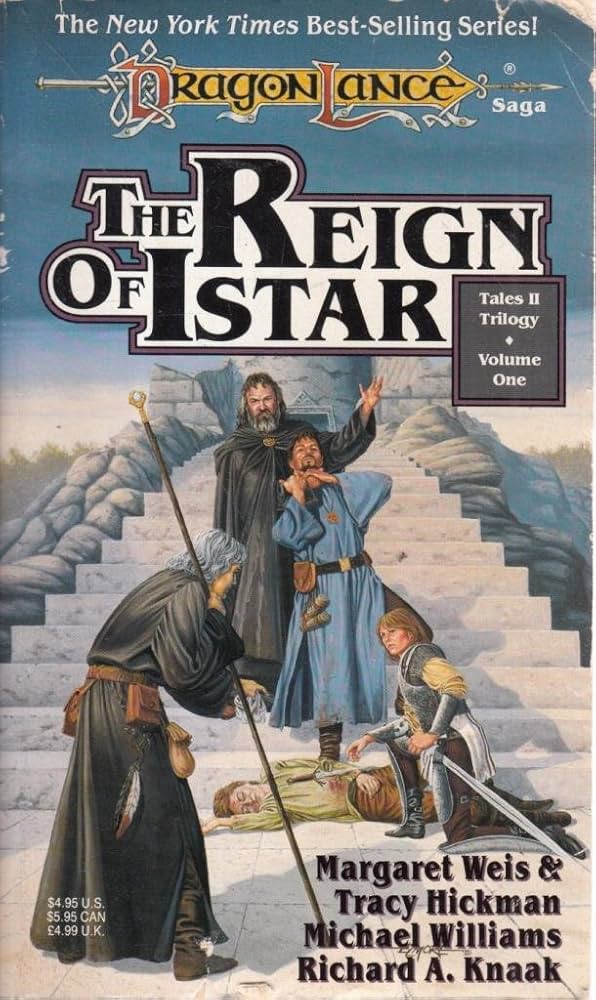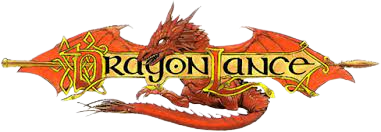The Reign of Istar

Table of Contents
ToggleOverview
The Reign of Istar is a thematic anthology set during one of the most defining and tragic eras in Krynn’s history: the final years of the Kingpriest’s rule in the empire of Istar, leading up to the Cataclysm—a world-shattering divine punishment that reshaped the face of Krynn forever.
Unlike earlier Tales volumes, which often explored humor, heroism, or romance, The Reign of Istar is much more focused on power, prophecy, morality, and downfall. It offers multiple perspectives on how the religious and political tyranny of the Kingpriest affected people across all walks of life—clerics, outcasts, nobles, soldiers, and even dragons.
This is an anthology of quiet tragedies, defiance, and moral questions, showcasing how an empire that saw itself as holy and righteous could fall so far into corruption.
Historical Context in the Dragonlance Timeline
- Era: Circa 0 PC (Pre-Cataclysm)
- Setting: The Empire of Istar, which had risen to become the most powerful and “divinely favored” nation on Krynn.
- The Kingpriest—a religious ruler claiming to speak for the gods of Good—had begun purging “evil” from the world, outlawing arcane magic, persecuting races, and seeking ultimate moral control.
- The gods warned Istar to stop. The Kingpriest ignored them.
- The Cataclysm followed—a fiery mountain cast down from the sky, destroying Istar and permanently altering the world.
This anthology shows the final days of Istar—the calm before the fire.
Purpose and Structure
This collection is designed to:
- Provide personal and moral perspectives on the decline of Istar
- Humanize characters caught between faith and doubt, duty and conscience
- Add depth to the mythic history of Krynn
- Explore the warning signs that led to one of the greatest disasters in Dragonlance lore
The stories vary in tone—from tragic to defiant, philosophical to action-driven—but all point toward the inevitable fall.
Notable Stories and Summaries
1. “Six Songs for the Temple of Istar” by Michael Williams
A stunning, poetic entry that weaves six vignettes through music, prophecy, and art. It captures the slow, tragic decay of faith and truth in the heart of Istar. Michael Williams’s lyrical style gives this story a timeless, elegiac feel. It sets the emotional tone for the anthology.
2. “The Three Lives of Horgan Oxthrall” by Douglas Niles
Follows a dwarf in exile who becomes a miner, a mercenary, and a prisoner—all under Istar’s regime. His life becomes a lens through which we see how Istar’s reach warps the lives of even the simplest men. A gritty, grounded take on the everyman crushed by empire.
3. “The Silken Thread” by Margaret Weis and Tracy Hickman
A beautiful and heartbreaking tale of a court weaver who becomes entangled in forbidden love—and Istar’s obsession with purity and sin. This story explores how art, beauty, and personal freedom are stifled by oppressive theocracy.
4. “The Bonds of Honor” by Richard A. Knaak
Centers on a Solamnic Knight serving in Istar, forced to confront the corruption of the state versus his personal code. The tale explores the tension between knighthood, loyalty, and conscience. A must-read for fans of the Solamnic Order.
5. “Bertrem’s Guide to the Age of Might” (excerpts)
Scattered throughout the anthology are fictional in-universe essays from Bertrem’s Guide, providing historical and scholarly commentary on Istar’s politics, religion, and laws. These interludes add flavor, context, and worldbuilding depth.
6. “Colors of Belief” by Dan Parkinson
An elven artist is commissioned by the Kingpriest’s clerics to paint a mural glorifying their ideals—but as he learns the real cost of Istar’s “holiness,” he must choose between art and propaganda. Themes of censorship, propaganda, and artistic truth shine here.
7. “The Kingpriest’s Trial” by Chris Pierson
A magical courtroom drama where a former cleric is put on trial for practicing arcane magic. A sharp, philosophical story that interrogates faith, justice, and tyranny through intense dialogue and tragic choices.
Themes
Faith vs. Fanaticism – The anthology explores how faith can become corrupted when paired with absolute power. Istar began as a nation of light—and ended in darkness.
Moral Grayness – There are no cartoon villains here—just people doing what they think is right, in a world where “right” has become twisted.
Suppression of Magic and Freedom – Several stories focus on how arcane mages, artists, and dissenters are persecuted for not conforming to Istar’s theocratic rule.
Prophecy and Inevitability – The looming Cataclysm hangs over every story, adding a tragic weight. Even small acts of resistance or hope are tinged with doom.
The Power of Individual Conscience – Though most characters can’t stop Istar’s fall, their personal moral stands become deeply meaningful, even heroic.
Tone & Style
This is one of the most serious and reflective Dragonlance anthologies:
- There’s little humor, and almost no lighthearted tales.
- The style ranges from elegant and poetic (Six Songs) to tense and dramatic (The Trial, The Bonds of Honor).
- Several stories evoke a sense of tragic inevitability, much like stories set on the Titanic or in Pompeii—you know what’s coming, but can’t look away.
Reception
The Reign of Istar is widely praised for:
- Mature themes and moral nuance
- Expanding on a key historical era often mentioned in mainline novels but rarely explored in depth
- Its lyrical, thoughtful writing, especially in stories like Six Songs for the Temple of Istar
It’s often regarded as the deepest and most literary of the Tales anthologies, recommended for readers who enjoy:
- Political fantasy
- Religious commentary
- Tragic world-shaping events told through intimate stories
Some readers do note that it lacks the action or humor of earlier Tales books—but that’s intentional. This is a somber, philosophical volume that treats its material with weight.
Final Thoughts
The Reign of Istar is a thoughtful, tragic, and morally complex collection of stories about the fall of a golden empire. Through personal tales of resistance, loss, love, and loyalty, it paints a chilling portrait of how good intentions—and unchecked power—can lead to catastrophe.
It’s essential reading for:
- Dragonlance fans curious about the Age of Might and Cataclysm
- Readers who love dark historical fantasy and tragic downfall narratives
- Anyone interested in stories about resisting religious tyranny and cultural collapse
